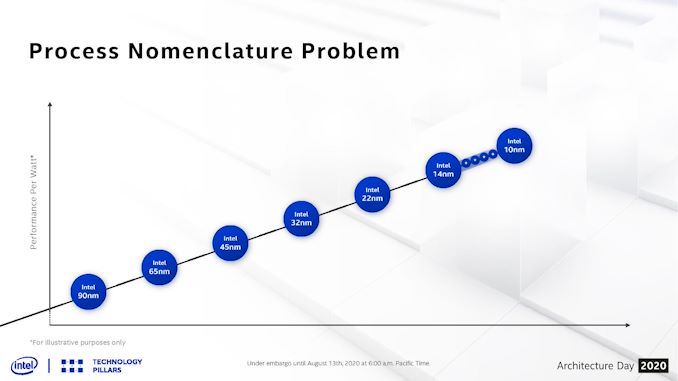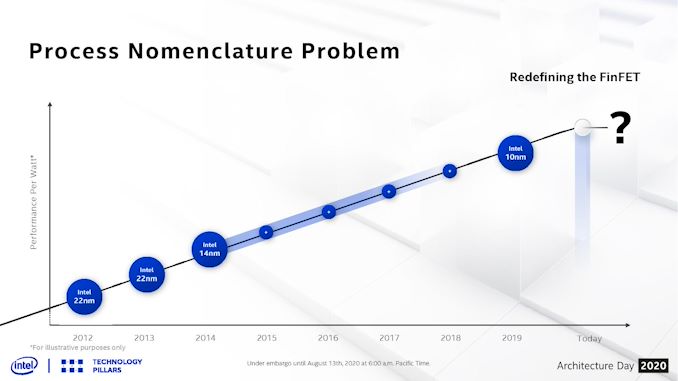What Products Use Intel 10nm? SuperFin and 10++ Demystified
by Dr. Ian Cutress on September 25, 2020 9:00 AM EST_678x452.jpg)
For our audience that regularly keeps track of Intel’s product portfolio, it would be hard to miss that the naming strategy of Intel’s process node technologies is a bit of a mess. To some, those words are themselves an understatement, as Intel has shifted its naming strategy 2-3 times since the launch of Intel’s first 10nm products. Not only that, even Intel’s various departments internally have a hard time keeping track of ‘what is this manufacturing process being called today’ when the press like AnandTech ask for details on the latest upcoming products.
Knowing this, and knowing what issues Intel has been having, I wanted to demystify Intel’s manufacturing process naming scheme such that users and engineers alike, even if they are inside Intel, can understand what is what but also importantly why. The why is the crucial factor.
If you're looking for a handy decoder ring for Intel's 10nm Products, it's here in page 3.
Why Do We Have Multiple Versions of a Process?
With Intel’s 14nm, we were invited to 14nm, 14+, 14++, 14+++, and if you believe Intel’s own slides, there were variants that went beyond this ++++ naming scheme. Each one of those additional + points on the end of the name signified a change in the process technology – usually to assist for increasing performance or efficiency.
Each one of these + points is an update to the BKM, or Best Known Methods.
While an engineer can draw an electrical layouts for a part of a processor, such as an addition circuit, actually applying that design to a silicon floorplan for manufacturing is a different skill altogether. Transistor libraries are designed to take advantage of a given process, and when a floorplan is optimized for a process, it can then be pasted and repeated as necessary – on top of this, simulation on thermals, power, and current density are applied to ensure that there are no hotspots or that critical paths inside the design have as few bottlenecks as possible.
When an update to the BKM occurs, two things can happen. Normally we see the update on the level of the transistor library that is changed – if the distance between two fins on a transistor increases for example, the transistor library and the macros may be made bigger, and then the floorplan might be redesigned to take account for this. As for any process node design, there are 100 different controls, and improving one might make three other controls worse, so it is a fine balancing act. Not only this, but the BKM has to be validated at the manufacturing level. The BKM update could apply to the metal stack as well, which in of itself can adjust the performance.
In the long long past, BKM updates were never advertised externally. If Intel or TSMC or another foundry discovered a way to improve the performance, or decrease the voltage, or improve the yield, the update was silently rolled into the design and nothing much was made of it. Sometimes processors would be listed as ‘1.0 volts to 1.35 volts’, and it would just be a roll of the dice if a user obtained one of the lower voltage models.
However, as time between different process node updates has elongated, these BKM updates have started to be identified and effectively monetized by the semiconductor companies. An update to a process that improves the voltage by 50 millivolts and increases frequency by 200 MHz immediately becomes a productizable event, and products built on these updates can be offered for more money over the usual. Or, depending on the rate of updates, the whole next generation of products could be built on the update.
So we never saw BKM updates officially announced at Intel’s 45nm, 32nm, or 22nm process nodes. These updates were fast enough that the productization of any update didn’t warrant a full round of marketing. With 14nm, that changed.
Intel had discussed its roadmap beyond 14nm since its 2010 Investor Meeting. It predicted that the company would be on 14nm by 2013, 10nm by 2015, and 7nm by 2017. As we now know, 14nm was two years late, and 10nm was 2-4 years late. Because of the introduction of 10nm being delayed, Intel decided to productize its 14nm BKM updates, and signified those with + points.
Intel’s current official line is that there have been four updates to 14nm, creating five ‘generations’.
More Plus Means More Meme
Because of all the + points, Intel’s marketing sometimes getting it wrong, and perhaps a little bit of ‘++’ in most programming languages meaning ‘+1’, the whole concept of adding + to the process node has become a meme – a meme at Intel’s expense, purely on the basis of its failure to deliver 10nm before the 14++++ naming scheme got out of hand.














143 Comments
View All Comments
michael2k - Saturday, September 26, 2020 - link
And it will be competing against the 2nd generation 3080.Spunjji - Monday, September 28, 2020 - link
2nd generation 3080? What's that supposed to be? If you're talking about the variant with 20GB RAM, that's hardly "second gen" and people are going to be very disappointed when they realise how pointless it is to have so much VRAM at this point in time.Overall I'm loving the idea that we shouldn't believe RDNA 2 will release this year despite the evidence to the contrary, and that it'll be terrible despite evidence to the contrary, but that we should believe there will be a "2nd generation 3080" despite there being *no* evidence in favour of such an assertion. Classic FUD.
wumpus - Monday, September 28, 2020 - link
It was a mistake for most consumers to buy Turing. Jensen even admitted that with the "it's safe to upgrade from Pascal now" bit.No idea if "Vega VII" was a mistake for AMD, but it was what very few consumers needed.
Operandi - Friday, September 25, 2020 - link
I think the best thing for the market is for Intel to take a bit more of a beating. Intel was complacent and/or they had run of real engineering problems (probably a bit of both) and AMD came back with a great CPU design but AMD's market position is still pretty weak. Intel still pushes the OEMs around in the server and notebook market. Its apparent in the product stacks but what is less apparent is whatever deals are happening behind closed doors."Cutting deals" of varying degrees of legitness and shadiness are always going to exist but the asymmetrical nature of AMD and Intel's position in the market in terms of capacity and capital make the market inherently unhealthy. It dosn't need to be 50/50 market share but I think Intel still needs to be taken down a peg or two so AMD can position itself (and the market along with) for the long term.
Spunjji - Friday, September 25, 2020 - link
Have to agree. I see Intel voluntarily bloodletting and find it hard to see that as anything other than overdue consequences for their corporate mentality.wumpus - Monday, September 28, 2020 - link
I'm not sure how much Intel can push OEMs around in the server room after AMD could supply the chips and Intel couldn't. Also the really big boys (AWS/Google/MS) don't need the OEMs, and AMD is getting in there.It looks like their old tricks are working just fine in the notebook market, although this is the first generation that AMD has really tried to crack it. OEM's might just think it isn't worth annoying Intel until AMD can get a few generations shipping.
wolfesteinabhi - Friday, September 25, 2020 - link
we can now officially say "14nm" instead of +ThumbsUp+ here on Anandtech now. .... who needs an outdated like icon anyhow!!Hifihedgehog - Friday, September 25, 2020 - link
14nmsharathc - Friday, September 25, 2020 - link
Intel is demeaning the symbol of '+'jbwhite1999 - Friday, September 25, 2020 - link
25 years ago this fall, Intel had a problem with multiplication of large numbers, so in essence, they have experience demeaning math like "+"